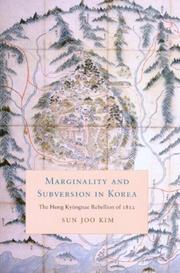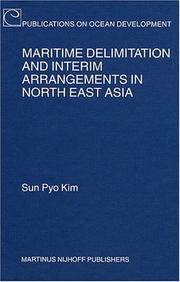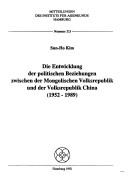| Listing 1 - 10 of 58 | << page >> |
Sort by
|
Book
ISBN: 1536178381 Year: 2020 Publisher: New York : Nova Science Publishers,
Abstract | Keywords | Export | Availability | Bookmark
 Loading...
Loading...Choose an application
- Reference Manager
- EndNote
- RefWorks (Direct export to RefWorks)
Book
ISBN: 9781407313511 1407313517 Year: 2015 Volume: 2700 Publisher: Oxford : Archaeopress,
Abstract | Keywords | Export | Availability | Bookmark
 Loading...
Loading...Choose an application
- Reference Manager
- EndNote
- RefWorks (Direct export to RefWorks)
Bronze age --- Land settlement patterns, Prehistoric --- Megalithic monuments --- Excavations (Archaeology) --- Age du Bronze --- Colonisation intérieure --- Monuments mégalithiques --- Fouilles (Archéologie) --- Types préhistoriques --- Korea --- Corée --- Antiquities --- Antiquités --- Antiquities. --- Colonisation intérieure --- Monuments mégalithiques --- Fouilles (Archéologie) --- Types préhistoriques --- Corée --- Antiquités

ISBN: 9780295986845 0295986840 9780295989310 0295989319 029580338X 9780295803388 Year: 2007 Publisher: Seattle University of Washington Press
Abstract | Keywords | Export | Availability | Bookmark
 Loading...
Loading...Choose an application
- Reference Manager
- EndNote
- RefWorks (Direct export to RefWorks)
Hong Kyong-nae Incident, 1811-1812 --- Korea --- History --- K9155 --- K9300.50 --- K9309 --- Korea: History -- late Chosŏn period, isolation, Qing dependency (1600-1895), Manchu invasions (1627, 1637) --- Korea: Social sciences -- social and cultural history -- Chosŏn period (1392-1910) --- Korea: Social sciences, society -- social theory, movements and protests --- Hong Kyŏng-nae Incident, 1811-1812 --- Korea - History - 1637-1864 --- Hong Kyŏng-nae Incident, 1811-1812.

ISBN: 900413669X 9786610914838 9047404807 1280914831 1429414804 9781429414807 9789004136694 Year: 2004 Publisher: The Hague ; New York : M. Nijhoff,
Abstract | Keywords | Export | Availability | Bookmark
 Loading...
Loading...Choose an application
- Reference Manager
- EndNote
- RefWorks (Direct export to RefWorks)
This work will be a useful guide for those who look for rules and practice on the relations between neighboring States in the absence of maritime boundaries. The main question the author is trying to tackle is how to handle the relations between neighboring coastal States when there is no maritime boundary in place. This book attempts to clarify the legal issues of exploitation of oil, gas and fisheries resources, and jurisdictional conflicts with regard to marine scientific research and protection of the marine environment in disputed areas. This book shows numerous instances of provisional arrangements in disputed areas around the globe together with as many as forty-five valuable maps. The author, a scholar and diplomat of Korea, gives an up-to-date and in-depth analysis of the complicated legal issues of maritime delimitation and provisional arrangements in North East Asia. The English texts of the provisional arrangements in the region annexed to the book are also valuable materials.
Territorial waters --- Economic zones (Law of the sea) --- Continental shelf --- Continental margins --- Economic zones (Maritime law) --- Exclusive economic zones (Law of the sea) --- Patrimonial sea (Law of the sea) --- Law of the sea --- Contiguous zones (Law of the sea) --- Limit, Three-mile (Territorial waters) --- Marginal sea (Territorial waters) --- Maritime belt (Territorial waters) --- Territorial sea --- Three-mile limit (Territorial waters) --- Bodies of water --- Jurisdiction, Territorial --- Territory, National --- Innocent passage (Law of the sea)
Book
ISBN: 0295802170 9780295802176 0295990414 9780295990415 Year: 2010 Publisher: Seattle Center for Korea Studies, University of Washington University of Washington Press
Abstract | Keywords | Export | Availability | Bookmark
 Loading...
Loading...Choose an application
- Reference Manager
- EndNote
- RefWorks (Direct export to RefWorks)
Ethnicity --- Regionalism --- Ethnic identity --- Group identity --- Cultural fusion --- Multiculturalism --- Cultural pluralism --- Human geography --- Nationalism --- Interregionalism --- P'yŏngan-bukto (Korea) --- Hamgyŏng-bukto (Korea) --- Hwanghae-bukto (Korea) --- Hwanghae-pukto (Korea) --- Hwanghae-do (Korea) --- Hamgyŏng-pukto (Korea) --- Kankyŏ Hokudō (Korea) --- North Hamgyŏng Province (Korea) --- Hamgyŏng-pukto --- Pʻyŏngan-pukto (Korea) --- Heian Hokudō (Korea) --- Chagang-do (Korea) --- Pʻyŏngan-do (Korea) --- History. --- K9250 --- K9335.50 --- Korea: Geography and local history -- North Korea --- Korea: Communities, social classes and groups -- North Korea
Book
ISBN: 0804786658 9780804786652 0804783810 9780804783811 Year: 2013 Publisher: Stanford, CA Stanford University Press
Abstract | Keywords | Export | Availability | Bookmark
 Loading...
Loading...Choose an application
- Reference Manager
- EndNote
- RefWorks (Direct export to RefWorks)
Kim resurrects the forgotten historical memory of people, family, lineage, and region, while at the same time enriching the social history of late Choson Korea, by examining the life and work of Yi Sihang, a historically obscure person from a hinterland in the northwestern region, but an advocate of the history and culture of the region he came from and a literatus whose literary talent was recognised by his contemporaries.
Elite (Social sciences) --- Central-local government relations --- Center-periphery government relations --- Local-central government relations --- Local government-central government relations --- Political science --- Decentralization in government --- Federal government --- Elites (Social sciences) --- Leadership --- Power (Social sciences) --- Social classes --- Social groups --- History --- Yi, Sihang, --- P'yongan-do (Korea) --- Korea --- P'yŏngan-namdo (Korea) --- P'yŏngan-bukto (Korea) --- Historiography.
Book
Year: 1963 Publisher: Seoul Yonsei University Press
Abstract | Keywords | Export | Availability | Bookmark
 Loading...
Loading...Choose an application
- Reference Manager
- EndNote
- RefWorks (Direct export to RefWorks)

ISBN: 3889101100 Year: 1992 Volume: 213 Publisher: Hamburg : Institut für Asienkunde,
Abstract | Keywords | Export | Availability | Bookmark
 Loading...
Loading...Choose an application
- Reference Manager
- EndNote
- RefWorks (Direct export to RefWorks)
China --- Mongolia --- China --- Chine --- Mongolie --- Chine --- Foreign relations --- Foreign relations --- Foreign relations --- Relations extérieures --- Relations extérieures --- Relations extérieures
Book
ISBN: 9781433181856 1433181851 Year: 2022 Publisher: New York Peter Lang
Abstract | Keywords | Export | Availability | Bookmark
 Loading...
Loading...Choose an application
- Reference Manager
- EndNote
- RefWorks (Direct export to RefWorks)
"The Mongolian Empire, which reigned over the Eurasia Continent, was a great empire in the Middle Ages. Now, however, it is a divided nation, with a current population of about 10 million people, all of whom are distributed throughout the region, which contact with borders of the east, west, north, and south of (Outer) Mongolia. This book aims to offer a thrilling exploration of Mongolia's past, present, and future, in the context of Mongolians in the 20th Century. This book details the region's historical development for the first half of the 20th century by tracing Mongolia's history with rare materials. In addition, the relationships between both Inner Mongolia and China, and Outer Mongolia and Russia, are analyzed in-depth. Then, accounting for the second half of the 20th century, the author offers an in-depth analysis of Inner & Outer Mongolia, which have changed greatly since the era of reform and their opening-up. These exciting analyses are based on field surveys conducted by author every year since 1990. Through synthesizing forty years of studies on Mongolia, including field surveys, the author analyzes the modern relationship between Inner Mongolia and Outer Mongolia, organized by subject and period. Also, the author argues that a unified Mongolia could become a serious threat to neighboring countries, such as China and Russia, in part because Mongolian are gathering under a spiritual leader named Chinggiskhan. Therefore, the question pursued in this book is: How can modern-day Mongolian achieve cohesion, thereby re-establishing a unified Mongolia? In response, this book argues that unification could be attained by linking Mongolia's economic development, political stability and maintenance of cultural identity, and to do so based on 'Chinggiskhanism' in a post-reform era. In this comprehensive 20th-century history of Mongolia, readers not only can come to understand why Mongolian became divided into two regions, Inner Mongolia and Outer Mongolia, but also readers will come to understand Mongolia's socio-cultural relationship with China. Truly, this book can serve readers as an opportunity to better understand the 'development of relations for former glory between Mongolian peoples' based on the change in relationship between Inner Mongolia and Outer Mongolia after undergoing significant reforms and opening up"--
Mongols --- Ethnic identity --- Mongolia --- Inner Mongolia (China) --- China --- Soviet Union --- History. --- Politics and government --- Politics and government. --- Relations
Book
Year: 1963 Publisher: Seoul Yonsei University Press
Abstract | Keywords | Export | Availability | Bookmark
 Loading...
Loading...Choose an application
- Reference Manager
- EndNote
- RefWorks (Direct export to RefWorks)
| Listing 1 - 10 of 58 | << page >> |
Sort by
|

 Search
Search Feedback
Feedback About UniCat
About UniCat  Help
Help News
News